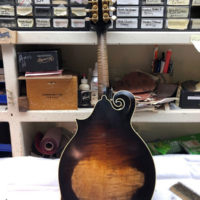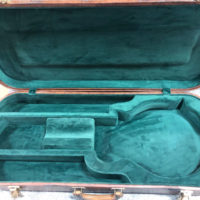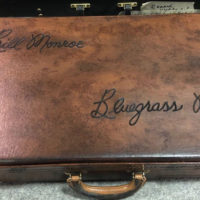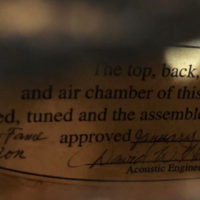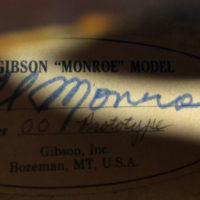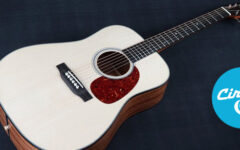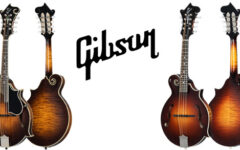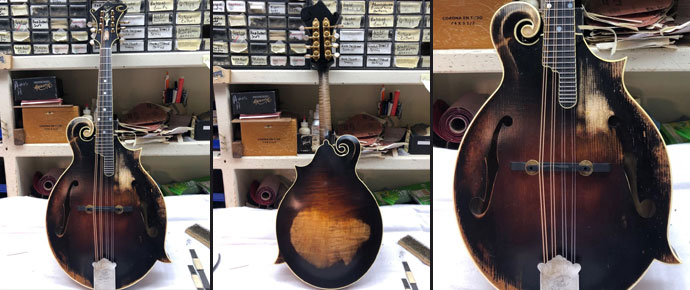
Gibson created quite a stir among mandolin aficionados at last week’s NAMM Show in Anaheim with the first public display of their new Bill Monroe Hall of Fame mandolin. It was built by Gibson master luthier David Harvey and his team as a replica of Big Mon’s iconic Loar F-5, currently on display at the Country Music Hall of Fame & Museum in Nashville.
Harvey built the mandolin to the specifications of Monroe’s 1923 model, and then distressed it to match the appearance of its present condition. No instrument in the history of bluegrass music is as storied as this one, which Monroe purchased in a barbershop back in 1944 or ’45. Over its life this mandolin traveled the world, played alongside Lester Flatt and Earl Scruggs, and pioneered a style of playing that survives today in the music he created.
For David, who grew up studying Monroe’s music, seeking to emulate the sound and feel he got with this F-5, the process of recreating it has been a labor of love. The project is being done less as a replica, and more as an honor to the man who inspired multiple generations of mandolinists, Harvey tells us.
“It’s a tribute, done out of respect to Bill Monroe. This is a way to shine a light on a guy who is responsible for a genre of music that we love so much… a way to pay homage to Bill Monroe and the music he created.”
Though this Hall of Fame prototype is the only one built to date, Gibson is taking orders for them now. Each one will ship with a Bill Monroe signed label, left over from a previous production run of Monroe models made in Montana some years ago.
And the company is considering three different models of this special instrument, based on plans that started some time back.
“The Hall of Fame program came about a few years ago when we were talking about making a number of copies of the mandolin for a proposed Bill Monroe movie. The project has since been abandoned is still in development, but the film company had asked us to build three different versions of the instrument: what we were calling the Barbershop Mon, the way it would have looked when Bill bought it from a barber shop window about 1945, the Mad Mon, during the period when Monroe was angry with Gibson and had broken off the headstock scroll and scratched out the pearl Gibson logo, and the Hall of Fame Mon, which is how it looks today.
If it hadn’t been for the flood, we’d have started this much sooner.”
The flood in question occurred in 2010 when the Cumberland River crested way above its banks in early May, completely flooding the Gibson mandolin facility in the Opryland mall. The entire shop was underwater for days, with much of the company’s tooling and jigs destroyed in the wake.
Serious students of Monroe’s life recall the time of the Mad Mon, when he disfigured this valuable icon in a fit of pique against the makers. But he and Gibson ultimately made up, and they restored the headstock to original condition for him. Later they did a complete restoration when a woman annoyed with Bill took a fireplace poker to the top and broke it into splinters.
David says that the hardest part was matching the look in creating this prototype, which is now the working model for the production run.
“It’s very time consuming to do the distressing. We have some really good pictures, so I’m trying to get a good match on the colors.”
From the photos released of the Hall of Fame F-5, it would seem that he has captured them quite well.
Harvey came to Gibson in 2004 in Repair and Restorations, working at the time under Charlie Derrington, then moved to head up the mandolin department in 2007. He recalls Monroe stopping by the shop in Nashville from time to time for minor tweaks on his instrument. It was Derrington and his Gibson team who had restored the mandolin after being smashed in 1985, taking three months to complete the delicate process to salvage the original top wood.
Orders are being accepted now through Gibson dealers, with a suggested street price of just under $25,000 for the Hall of Fame model. They will be all hand made, of the finest spruce and maple available, and shipped in a custom Bill Monroe case with an aged rawhide bootlace strap and a rattlesnake rattle inside the mandolin, like Bill’s!
David says that work on subsequent prototypes in ongoing.
“We are proud to offer the regular guy mandolinist a chance to own a keepsake such as this. If they love Monroe like we do, they will cherish it forever.”
For those attending the SPBGMA convention in Nashville this weekend, David will have the mandolin with him for his showcase performance Friday evening in the Vine Grove Bluegrass room. He invites all interested mando-fans to stop by for a look.


